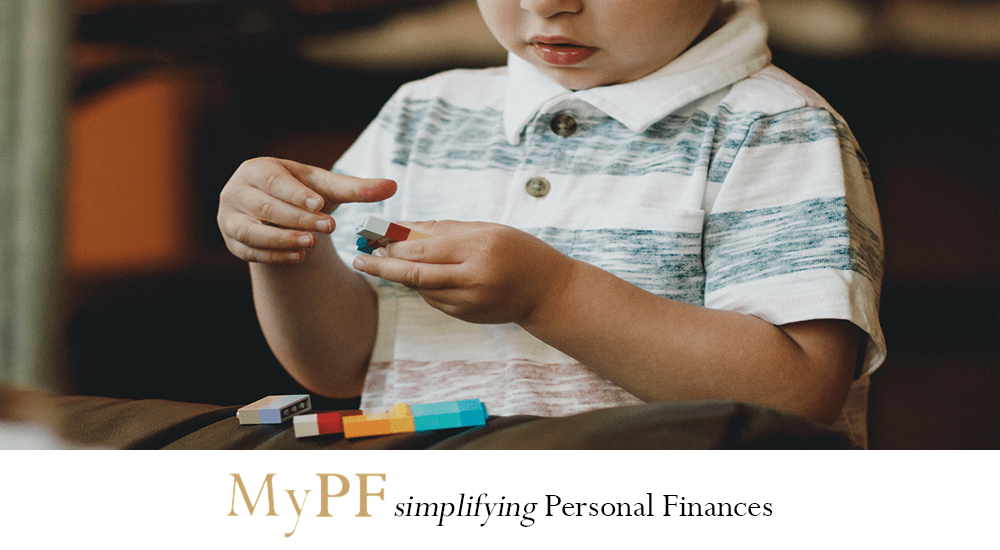It’s never to early to begin, even with your 3 year old child. With her academic background in Psychology coupled with her professional experience as an educator at an international preschool and in counselling, Viv shares her tips on teaching kids about money.

A child’s mind is like a playground filled with endless supply of Lego. Concepts are constantly formed and reconstructed, memories (good and bad) are created and compartmentalized, and skills they need to survive in this world are acquired and refined through play and interaction with others. With this in mind, inculcating best personal finance practices in children can begin as early as preschool years and it can be a fun experience for you and your child.
Contents
#1. Play
“Play is the answer to how anything new comes about.” – Jean Piaget
This quote by Jean Piaget (a clinical psychologist renowned for his pioneering work in child development) simply means that play is crucial in a child’s learning and cognitive development. He went on to add that “When you teach a child something, you take away forever the chance of discovering it for himself.”
While it is important to teach kids, it’s even more important to allow children to discover and understand something on their own. Since play is the language of a child, you can incorporate math during play.
For example, use toys to create a marketplace or shopping scene and play pretend customer and cashier roles. Children can count the number of items they have ‘purchased’ in their imaginative trolley/shopping bag or be the cashier collecting money. You can also change scenes and roles based on your child’s preference i.e. restaurants, toy store, hair salon, etc. Additionally, you can use Unifix Cubes to illustrate conservation of numbers which are widely used in preschools today to teach mathematics.
#2. Set an Allowance
Start your kids as young as age 3-4 by giving them a small weekly allowance/pocket-money and 3 coin boxes (ziplock bags or containers work fine too).
Explain the usage of the 3 coinboxes:
- The 1st coinbox is for saving. The money put in here can be saved to buy something that they want and for their future education.
Tip: Your child starts to learn how much money it takes to buy a toy he/she wants. You can do a ringgit for ringgit matching to help with bigger purchases. - The 2nd coinbox is for investing. Explain that money put in here is used to make more money.
Tip: You can be the FAMA bank giving your child monthly interest. Other ideas are to introduce entrepreneurship to your child (Ribena stand!), buying a single stock (or fraction of a stock) in a company (Disney?) and putting money in the bank under children’s savings account. - The 3rd coinbox is for giving. Explain that money in this bag is used to help others in need.
Tip: Your child learns to care and show love for others in a real way. Model being thankful and giving cheerfully yourself.
Help your child to label the coinboxes if they can’t write yet while your older child can label them on his/her own. This gives them a sense of responsibility over their belongings and lets them learn the consequences of their actions.
Keep a simple accounting record of the money incoming and outgoing which teaches them basic financial management. Once your child is older, he/she can do the recording on their own with your supervision.
#3. Practice Chores
Let your child do chores to earn extra income (or set an expectation on home chores for an allowance). Start training your child to be independent and proactive to help around at home. Give them a list of chores that they can choose from and reward them accordingly. This can include optional extra chores like washing the car. This ‘income’ earned is to be divided into the 3 coinboxes. For older children, you can allow the child to divide up the income at the child’s discretion.
#4. Value
Encourage price comparisons and emphasize on value. Before purchasing something, check and compare prices to look for the best deals.
For example, 1 box of cereal from Brand A may cost RM 12 for 500g and 1 box of cereal from Brand B may cost RM15 but for 1kg. Although Brand A may seem cheaper but Brand B offers more value. You can explain value by ‘having more at the same price or less”.
This is not about being kiasu but your child learns to be wise and prudent in spending decisions.
#5. Practice What You Preach
Your child will most likely adopt your values about money and your behavior reflects your values. So, do the things you want your child to learn and imitate. Let your actions be congruent with your words. If you ask your child to save but spend unnecessarily on things you don’t need to impress people you don’t know; don’t blame your child if your advice falls on deaf ears. The current trend seems to be heading towards a spending competition (i.e. to obtain the most, the best or latest…) and not competing to save (i.e. setting aside funds for savings, retirement, investments).

#6. Delay Gratification
Let’s say your child wants a new toy and after comparing prices with your child at various malls, you discovered that the mall will be offering extra discounts due to its Member’s Day promotion a week later. Explain the situation to your child and offer an extra incentive for purchases made a week later. Remind your child of the value lesson learnt and let your child decide.
In a study conducted by psychologist Walter Mischel in 1970 on delayed gratification, he discovered that children who were able to delay gratification performed better at school and completed college at higher rates and earned higher income as adults compared to those who had trouble delaying gratification.
“What a child can do in cooperation today, he can do alone tomorrow” ~ Lev Vygotsky (a 20th century developmental psychologist who developed the sociocultural theory of child development.)
Start Today!
Start teaching your children about managing finances today. There is no ‘right’ age to learn about savings, investments, and financial planning. Even children as young as 2 or 3 begin to understand the concept of money. Your child is more capable than you think.
Ultimately, we want our children to be confident, independent and successful individuals who are able to fend for themselves. There’s only so much you can guide them now in preparation for tomorrow. The rest is on their own. Your children will have to write their own story. There’s no escaping the hard lessons in life while they transition into adulthood but the lessons can be less costly and painful if we do our part now.
More info
- The Power of Delaying Gratification (psychologytoday.com)
Have you tried the suggestions in this article? Do you have any other tips to share for other parents?





Leave A Comment